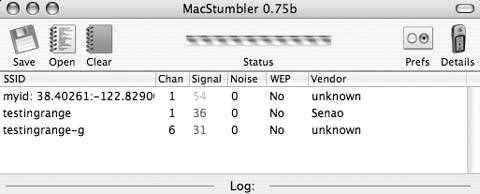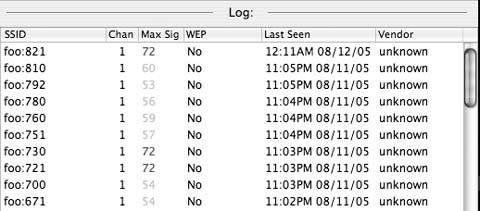Hack 21. Broadcast Your GPS Position


Entertain yourself and passing wardrivers by abusing the beacon frame (and MAC address).
Have you ever wanted a lightweight protocol that would allow you to broadcast your current position? Many times you can see a wireless network, but you can't connect to it. In the NoCat community network (http://nocat.net) we would often do sight surveys that showed lots of networks, but we could not associate with them. Perhaps the access point has a more powerful network card, or a better antenna, and is able to blast a signal out, but you are not able to get your signal back to the access point.
What to do? With a complete abuse of the 802.11 beacon frame you can share your position with anyone around you!
802.11 wireless networks in both Ad Hoc and Infrastructure mode [Appendix A] send periodic beacon frames. These are about 50 bytes long and contain information that a client needs in order to associate with a wireless network. The beacon frame includes the Service Set Identifier (SSID), which is the name of the network.
Wireless discovery programs such as NetStumbler [Hack #24], iStumbler [Hack #27], and Kismet [Hack #29] get all of their information from sniffing for these beacon frames. So what happens if we change the SSID on the access point? What happens if we change it whenever we get a new GPS fix?
For our purposes the SSID, at 32 bytes, provides enough room to encode the latitude and longitude of our current position to 5 digits of precision (about 1 meter). We can also separate the coordinates with readable delimiters and still have 11 characters for a unique station ID.
To run this hack, you need to have a DIY Linux access point [Hack #63]. Then, set up the GPSd daemon and connect a GPS [Hack #20].
Once you have your access point and GPSd functional, use the Perl script in Example 1-2 to broadcast your current position by using the beacon frame.
Example 1-2. Broadcasting your position through GPSd using beacon_abuse.pl
#!/usr/bin/perl
# /usr/local/sbin/gpsd -p /dev/ttyS0
use 5.6.1;
use IO::Socket;
use Term::ReadKey;
use strict;
BEGIN { $|++ }; # autoflush STDOUT.
my $station_id = shift( @ARGV ) || 'myid';
my $GPSD = shift( @ARGV ) || "localhost:2947";
my $delay = 3; # number of seconds to sleep
my $ssid = 'gpsd not initialized';;
# Connect to gpsd.
warn "connecting to gpsd
";
my $gps = IO::Socket::INET->new($GPSD)
or die "Can't connect to gpsd at $GPSD: $!
";
while (1) {
# Tell gpsd we want position, altitude, date, and status.
$gps->print("pads
");
# Parse out the response. If the date is blank, gpsd needs
# a second to catch up.
my $location = <$gps>;
my ($lat, $long, $alt, $date, $status) =
($location =~ /P=(.+?) (.+?),A=(.+?),D=(.+?),S=(.+?)/gos);
# create new SSID
$lat = sprintf("%9.5f", $lat);
$long = sprintf("%10.5f", $long);
$ssid = "$station_id:$lat:$long";
print "$ssid
";
`iwconfig wlan0 essid "$ssid" mode "Master" channel 1 rate "Auto"`;
sleep( $delay );
}
Copy the code into a file called beacon_abuse.pl and run it from the command line:
$ ./beacon_abuse.pl myid
In this example, myid is the unique station ID that will preface the latitude and longitude in the SSID generated by the code. The code enters a loop where it connects to GPSd to get the current position, then changes the SSID of the network card and prints out the new SSID. You will know it is working if you get a series of new SSID's that consist of your station ID and the latitude and longitude; for example:
myid: 38.40254:-122.182889
Depending on your platform you can use MacStumbler, NetStumbler, or Kismet to watch the SSID change, as shown in Figure 1-57.
If your machine isn't moving too quickly, or you stop beacon_abuse.pl, you can connect to the machine as a normal access point, as shown in Figure 1-58.
Figure 1-57. Watching the moving SSID in MacStumbler

Figure 1-58. A geolocated access point

One disadvantage of the script in Example 1-2 is that your Stumbler program probably shows only the most recent SSID. This is because the programs use the MAC address of the wireless card to uniquely identify the access point. By design, this is the right thing to do, because MAC addresses are not supposed to change. Unless we want them to change.
This code flips the MAC address, and sets the SSID as well:
#!/usr/bin/perl
$cnt=0;
while (1) {
`ifconfig wlan0 hw ether 0000000000$cnt`;
`iwconfig wlan0 essid "foo:$cnt" mode "Master" channel 1 rate "Auto"`;
print "new essid foo:$cnt
";
sleep 1;
$cnt++;
}
Copy the code into a file called bad_plan.pl and run it from the command line:
$ ./bad_plan.pl
This is almost certainly a Bad Idea, but it does let you create amusing Stumbler logs like Figure 1-59 for passing wardrivers.
Figure 1-59. How to confuse a wardriver

Changing your SSID on a whim is almost certainly a bad idea, but imagine an event such as Burning Man (http://www.burningman.com), where the action happens in a wireless-friendly flat plane. You could add a wireless card to the computer to serve MP3s in your art car and broadcast your position with GPS. Since the beacon frame drops down to 1MB and is sent relatively infrequently, you could have quite a few location-aware vehicles sharing a single Wi-Fi radio channel.
This hack lets you communicate your position (or anything else you can convey 32-bytes at a time) to a client and there is no way for the server, or anyone listening in, to identify which clients are getting the position information. This technique has lots of disadvantages, not least of which is that it destroys all normal use of the link, but that's what makes it a hack.
1.22.1. See Also
- More on 802.11 beacons: http://www.wi-fiplanet.com/tutorials/article.php/1492071
Rich Gibson
Bluetooth, Mobile Phones, and GPS
- Hacks 122: Introduction
- Hack 1. Set Up Bluetooth on Linux
- Hack 2. Set Up Bluetooth on Windows XP
- Hack 3. Connect Mac OS X with a Bluetooth Phone
- Hack 4. Connect Linux with a Bluetooth Phone
- Hack 5. Connect Windows XP with a Bluetooth Phone
- Hack 6. Use Your Treo as a Modem
- Hack 7. Send SMS from a PowerBook
- Hack 8. Remote Control Mac OS X with Bluetooth Phones and PDAs
- Hack 9. Remote Control Linux with a Bluetooth Phone
- Hack 10. Control XMMS with Bluetooth
- Hack 11. Liven Up Parties with a Participatory Slideshow
- Hack 12. Send SMS from Linux
- Hack 13. Remote Control Windows with Bluetooth Phones and PDAs
- Hack 14. Control Your Bluetooth Phone with FMA
- Hack 15. Control Your Computer from Your Palm
- Hack 16. Control Your Home Theater from Your Palm
- Hack 17. Choose a Cellular Data Plan
- Hack 18. Blog from Your Mobile Phone
- Hack 19. Get Google Maps on Your Mobile Phone
- Hack 20. Share Your GPS
- Hack 21. Broadcast Your GPS Position
- Hack 22. Map Wi-Fi Networks with Kismet and GPSd
Network Discovery and Monitoring
- Hacks 2339: Introduction
- Hack 23. Find All Available Wireless Networks
- Hack 24. Discover Networks with NetStumbler
- Hack 25. Detect Networks with Handheld PCs
- Hack 26. Find and Join Wireless Networks with AP Radar
- Hack 27. Detect Networks on Mac OS X
- Hack 28. Scan Passively with KisMAC
- Hack 29. Detect Networks with Kismet
- Hack 30. Monitor Wireless Links in Linux with Wavemon
- Hack 31. Analyze Traffic with Ethereal
- Hack 32. Track 802.11 Frames in Ethereal
- Hack 33. Watch Network Traffic
- Hack 34. grep Your Network
- Hack 35. Check Wi-Fi Network Performance with Qcheck
- Hack 36. Estimate Network Performance
- Hack 37. Get Real-Time Network Stats
- Hack 38. Graph Your Wireless Performance
- Hack 39. Find Radio Manufacturers by MAC
Wireless Security
- Hacks 4051: Introduction
- Hack 40. Stop Moochers from Stealing Your Wi-Fi Bandwidth
- Hack 41. Visualize a Network
- Hack 42. Secure Your Linux Network with WPA
- Hack 43. Control Wireless Access by MAC
- Hack 44. Authenticate Wireless Users
- Hack 45. Forward Ports over SSH
- Hack 46. Proxy Web Traffic over SSH
- Hack 47. Securely Connect Two Networks
- Hack 48. Generate a Tunnel Configuration Automatically
- Hack 49. Poll Wireless Clients
- Hack 50. Interrogate the Network
- Hack 51. Track Wireless Users
Hardware Hacks
- Hacks 5262: Introduction
- Hack 52. Add an External Antenna
- Hack 53. Do-It-Yourself Access Point Hardware
- Hack 54. Boot from a Compact Flash Hard Drive
- Hack 55. Increase the Range of a PowerBook
- Hack 56. Send Power over Your Ethernet
- Hack 57. The NoCat Night Light
- Hack 58. Upgrade the Linksys WET11
- Hack 59. Scan for Wireless Networks Automatically
- Hack 60. Backlight Your Zipit
- Hack 61. Unwire Your Pistol Mouse
- Hack 62. Mobilize Your WRT54G with the WiFiCar
Software Hacks
- Hacks 6382: Introduction
- Hack 63. Build Your Own Access Point with Linux
- Hack 64. Bridge Your Linux AP
- Hack 65. Protect Your Bridge with a Firewall
- Hack 66. Filter MAC with HostAP and Madwifi
- Hack 67. Upgrade Your Wireless Router
- Hack 68. Set Up an OLSR Mesh Network
- Hack 69. Extend Your Wireless Network with WDS
- Hack 70. Pebble
- Hack 71. Wall Off Your Wireless
- Hack 72. Run Your Mac as an Access Point
- Hack 73. Run Linux on the Zipit Wireless Messenger
- Hack 74. Capture Wireless Users with NoCatAuth
- Hack 75. Capture Wireless Users on a Small Scale
- Hack 76. Build an Online Community in Your Offline Neighborhood
- Hack 77. Manage Multiple AirPort Base Stations
- Hack 78. Advertise Bonjour Services in Linux
- Hack 79. Advertise Any Service with Bonjour in Mac OS X
- Hack 80. Redirect Brought to you by Bonjour Ads
- Hack 81. Use a Windows-Only Wireless Card in Linux
- Hack 82. Use Your Orinoco Card with Hermes AP
Do-It-Yourself Antennas
- Hacks 8393: Introduction
- Hack 83. Make a Deep Dish Cylindrical Parabolic Reflector
- Hack 84. Spider Omni Antenna
- Hack 85. Pringles Can Waveguide
- Hack 86. Pirouette Can Waveguide
- Hack 87. Primestar Dish with Waveguide Feed
- Hack 88. Primestar Dish with Biquad Feed
- Hack 89. Cut a Cable Omni Antenna
- Hack 90. Build a Slotted Waveguide Antenna
- Hack 91. The Passive Repeater
- Hack 92. Determine Your Antenna Gain
- Hack 93. Build Cheap, Effective Roof Mounts
Wireless Network Design
- Hacks 94100: Introduction
- Hack 94. Analyze Elevation Profiles for Better Long-Range Wireless Networking
- Hack 95. Build a Wireless Network for the Large House
- Hack 96. Establish Line of Sight
- Hack 97. Calculate the Link Budget
- Hack 98. Align Antennas at Long Distances
- Hack 99. Slow Down to Speed Up
- Hack 100. Take Advantage of Antenna Polarization
Appendix A. Wireless Standards
- Appendix A. Wireless Standards
- Section A.1. 802.11: The Mother of All IEEE Wireless Ethernet
- Section A.2. 802.11a: The Betamax of the 802.11 Family
- Section A.3. 802.11b: The De Facto Standard
- Section A.4. 802.11g: Like 802.11b, only Faster
- Section A.5. 802.16: WiMAX Long Distance Wireless Infrastructure
- Section A.6. Bluetooth: Cable Replacement for Devices
- Section A.7. 900 MHz: Low Speed, Better Coverage
- Section A.8. CDPD, 1xRTT, and GPRS: Cellular Data Networks
- Section A.9. FRS and GMRS: Super Walkie-Talkies
- Section A.10. 802.1x: Port Security for Network Communications
- Section A.11. WPA & 802.11i
- Section A.12. BSS Versus IBSS
Appendix B. Wireless Hardware Guide
EAN: 2147483647
Pages: 178
